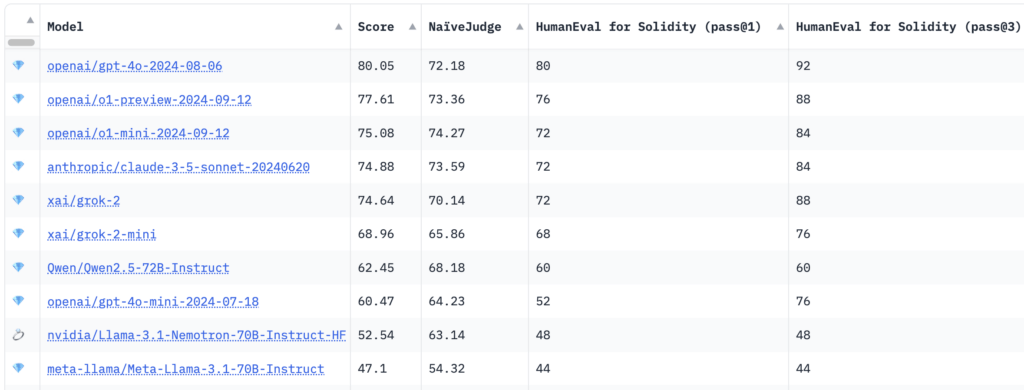
SolidityBench by IQ has launched as the primary leaderboard to guage LLMs in Solidity code technology. Obtainable on Hugging Face, it introduces two modern benchmarks, NaïveJudge and HumanEval for Solidity, designed to evaluate and rank the proficiency of AI fashions in producing good contract code.
Developed by IQ’s BrainDAO as a part of its forthcoming IQ Code suite, SolidityBench serves to refine their very own EVMind LLMs and evaluate them towards generalist and community-created fashions. IQ Code goals to supply AI fashions tailor-made for producing and auditing good contract code, addressing the rising want for safe and environment friendly blockchain purposes.
As IQ informed CryptoSlate, NaïveJudge gives a novel strategy by tasking LLMs with implementing good contracts primarily based on detailed specs derived from audited OpenZeppelin contracts. These contracts present a gold commonplace for correctness and effectivity. The generated code is evaluated towards a reference implementation utilizing standards comparable to purposeful completeness, adherence to Solidity finest practices and safety requirements, and optimization effectivity.
The analysis course of leverages superior LLMs, together with totally different variations of OpenAI’s GPT-4 and Claude 3.5 Sonnet as neutral code reviewers. They assess the code primarily based on rigorous standards, together with implementing all key functionalities, dealing with edge instances, error administration, correct syntax utilization, and total code construction and maintainability.
Optimization issues comparable to fuel effectivity and storage administration are additionally evaluated. Scores vary from 0 to 100, offering a complete evaluation throughout performance, safety, and effectivity, mirroring the complexities {of professional} good contract growth.
Which AI fashions are finest for solidity good contract growth?
Benchmarking outcomes confirmed that OpenAI’s GPT-4o mannequin achieved the best total rating of 80.05, with a NaïveJudge rating of 72.18 and HumanEval for Solidity move charges of 80% at move@1 and 92% at move@3.
Apparently, newer reasoning fashions like OpenAI’s o1-preview and o1-mini had been overwhelmed to the highest spot, scoring 77.61 and 75.08, respectively. Fashions from Anthropic and XAI, together with Claude 3.5 Sonnet and grok-2, demonstrated aggressive efficiency with total scores hovering round 74. Nvidia’s Llama-3.1-Nemotron-70B scored lowest within the high 10 at 52.54.

Per IQ, HumanEval for Solidity adapts OpenAI’s unique HumanEval benchmark from Python to Solidity, encompassing 25 duties of various problem. Every job contains corresponding assessments appropriate with Hardhat, a well-liked Ethereum growth setting, facilitating correct compilation and testing of generated code. The analysis metrics, move@1 and move@3, measure the mannequin’s success on preliminary makes an attempt and over a number of tries, providing insights into each precision and problem-solving capabilities.
Targets of using AI fashions in good contract growth
By introducing these benchmarks, SolidityBench seeks to advance AI-assisted good contract growth. It encourages the creation of extra subtle and dependable AI fashions whereas offering builders and researchers with helpful insights into AI’s present capabilities and limitations in Solidity growth.
The benchmarking toolkit goals to advance IQ Code’s EVMind LLMs and in addition units new requirements for AI-assisted good contract growth throughout the blockchain ecosystem. The initiative hopes to deal with a vital want within the business, the place the demand for safe and environment friendly good contracts continues to develop.
Builders, researchers, and AI fans are invited to discover and contribute to SolidityBench, which goals to drive the continual refinement of AI fashions, promote finest practices, and advance decentralized purposes.
Go to the SolidityBench leaderboard on Hugging Face to be taught extra and start benchmarking Solidity technology fashions.
🤖 Prime AI Crypto Belongings
View AllMentioned on this article








